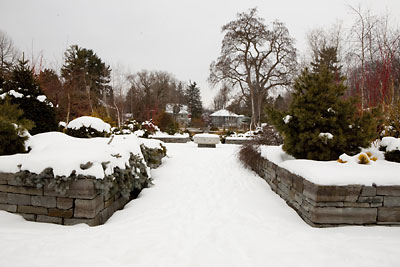Bark, berry and cone: The Mullestein Winter Garden offers color during Ithaca's snowy season
By Susan Kelley

Cornellians are all too familiar with the monotonous gray that covers Ithaca's winter landscape. Blood-red berries, blue-green needles, twisted scarlet stems and papery curls of bark offer some respite at the Mullestein Winter Garden at the Cornell Plantations.
The garden was designed to be as beautiful in the depths of winter as any other part of the Plantations would be in summer. More than 700 plants were chosen for their interesting bark texture or color, winter fruit, cones, evergreen foliage or unusual growth habit, said Jim Mack, horticultural supervisor. "We have cotoneaster planted in raised beds in the center of the garden, and it cascades over the wall stone in a fantastic way."

Groups of shrubby willows and dogwoods with red and yellow bark are cut back almost yearly to keep them vigorous, Mack said. "They show their best color when they have new growth." Many of the major conifers, including pine, spruce, fir and juniper, are represented. Most are dwarf varieties, which provide a dark backdrop for bright fruit of a deciduous holly known as winterberry.
Mack is partial to river birch. "A lot of people don't realize what beautiful bark it has -- both the texture, because it tends to curl off in plates, and the cream colors you don't usually see in many plants."
Peter Marks, professor emeritus of ecology and evolutionary biology, came up with the idea for a winter garden in 1998 when he visited one at the Cambridge University Botanic Garden. Planting began in 2000, with funds provided by Whitey Mullestein '32, a longtime benefactor of Cornell. As the garden has matured, staff members have filled in gaps with ornamental grasses and herbaceous plants.
Despite cold temperatures, visitors do come to the garden in the winter, Mack said. "They're drawn to mass plantings of willows and dogwoods. You can't help but notice the twig color. When the sun's out, with the snow backdrop, I don't think they can resist."
Media Contact
Get Cornell news delivered right to your inbox.
Subscribe